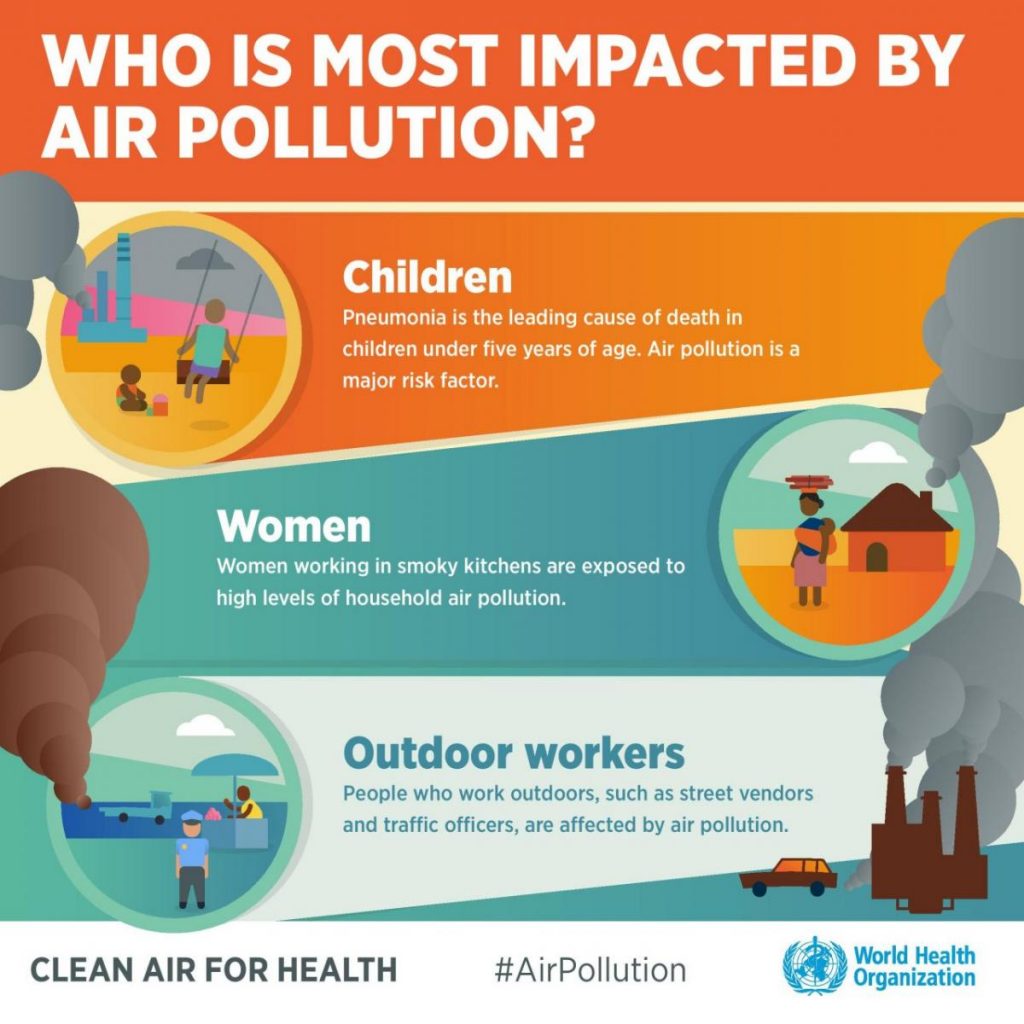Air is the “ocean” from which we breathe, as it supplies us with oxygen, which is essential for life. Human activities, however, release substances into the air, some of which cause pollution and problems for humans, plants and animals, as well as for the environment.
Air pollution
When people think about air pollution, they usually think about smog, acid rain, CFCs, and other forms of outdoor air pollution, but air pollution also exists inside homes and other enclosed spaces. Every year, the health of millions of people is affected by chemical substances present in the air within buildings, as well as in the open air.
The World Health Organization estimates that 4.2 million people die every year from air pollution. The combined effects of ambient (outdoor) and household air pollution cause about seven million premature deaths every year, largely as a result of increased mortality from stroke, heart disease, chronic obstructive pulmonary disease, lung cancer, and acute respiratory infections. It is therefore important to consider both indoor and outdoor air pollution.
Outdoor pollution
One type of air pollution is the release of particles (particulate matter) into the air from burning fuel for energy. The particles are very small pieces of matter, measuring about one-thousand of an inch, for example diesel smoke. This type of pollution is sometimes referred to as “black carbon” pollution.
In addition, the aexhaust from burning fuels in automobiles, homes and industries is also a major source of air pollution. Some researchers believe that even the burning of wood and charcoal in fireplaces and barbeques can release significant quantities of soot into the air.
Another type of air pollution is the release of noxious gases, such as sulfur dioxide, carbon monoxide, nitrogen oxides, and chemical vapors. These further react with other substances in the atmosphere, forming smog and acid rain.
Indoor pollution
Air pollution also occurs inside our homes, offices, and schools. Some of these pollutants can be created by indoor activities such as smoking, the use of certain aerosols and disinfectants, and even cooking. We spend about 80-90% of our time inside buildings, so our exposure to harmful indoor pollutants can be serious.
Global warming
The increase in atmospheric greenhouse gases due to human activities has resulted in global warming. This, scientists believed, has come from the buildup of carbon dioxide and other greenhouse gases in the atmosphere.
Greenhouse gases are produced when fossil fuels are burnt.
Plants play a crucial role in purifying the air, not only by converting carbon dioxide into oxygen, but also by removing pollutants from the air. However, the release into the air of carbon dioxide and other pollutants from human activities is much greater than the world’s plants can process. The situation is made worse since many of the earth’s forests are being removed, and plant life is being damaged by acid rain. Thus, the amount of greenhouse gases and other pollutants continue to increase. This buildup of greenhouse gases acts like a blanket and traps heat close to the surface of the earth, hence the increase in the earth’s temperature.
Ensure good air quality
Air quality is a tangible issue for many people, including business professionals and private citizens; yet, air quality is difficult to touch, see, taste or smell. It is very important to ensure good air quality, since ground-level ozone and particulate matter can trigger health and environmental problems such as asthma attacks and other respiratory problems, and even crop damage.
Simple things such as ensuring proper ventilation, using energy-efficient appliances, allocating proper storage facilities for hazardous products, wise choice and use of cleaners and pesticides, minimising or avoiding emissions from candles, cigarettes, barbecues, opening windows, and planting trees can go a long way in helping to ensure good air quality.
As the lead environmental regulator, the Environmental Protection Agency is responsible for ensuring clean air for all Guyanese through education, monitoring, and enforcement.
The Technical Services Programme Area ensures the enforcement of the Environmental Protection Act, and the Air Quality Regulations 2000 –
* Determine and establish the allowable level of atmospheric pollutants that can be emitted;
* Set limits for contaminants
* Set compliance schedule dates and times for existing facilities to comply with the required standards
* Establish the desirable national ambient air quality standard, to maintain a healthy air quality for humans and the environment.
A copy of the Air Quality Regulations can be downloaded at https://www.epaguyana.org/epa/regulations2/category/7-regulations
Sources
* https://www.who.int/health-topics/air-pollution#tab=tab_1
* Environmental Protection (Air Quality) Regulations 2000
You can share your ideas and questions by sending letters to: “Our Earth, Our Environment”, c/o ECEA Programme, Environmental Protection Agency, Ganges Street, Sophia, GEORGETOWN, or email us at: [email protected]. Follow us on Facebook and Instagram and subscribe to our YouTube channel.
